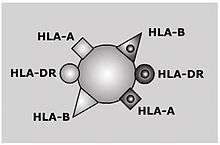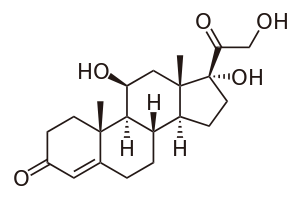Autoimmune polyendocrine syndrome type 2
| Autoimmune polyendocrine syndrome type 2 | |
|---|---|
|
| |
| HLA-DQ2 one of the human leukocyte antigens genotypes responsible for this condition | |
| Specialty |
Endocrinology |
| Risk factors | Human leukocyte antigen (HLA-DQ2, HLA-DQ8 and HLA-DR4)[1] |
| Diagnostic method | Ultrasound, MRI[2] |
| Treatment | Thyroid-stimulating hormone[3] |
Autoimmune polyendocrine syndrome type 2, a form of autoimmune polyendocrine syndrome also known as Schmidt's syndrome,[4] or APS-II, is the most common form of the polyglandular failure syndromes.[1] It is heterogeneous and has not been linked to one gene. Rather, individuals are at a higher risk when they carry a particular human leukocyte antigen (HLA-DQ2, HLA-DQ8 and HLA-DR4). APS-II affects women to a greater degree than men.[1]
Symptoms and signs
Symptoms(and signs) that are consistent in an individual affected by with Autoimmune polyendocrine syndrome type 2 are the following:[5][4][3]

- Nausea
- Frequent urination
- Palpitations
- Weight loss
- Anorexia
- Low blood pressure
- Hypoparathyroidism
- Myalgias
- Hashimoto thyroiditis
- Graves' disease
- Anaemia
- Hypogonadism
- Diabetes mellitus
Genetics

In terms of genetics one finds that autoimmune polyendocrine syndrome type 2 has an autosomal dominant(and recessive) inheritance[6][7] Furthermore, the human leukocyte antigen involved in this condition are HLA-DQ2(DR3 (DQB*0201)) and HLA-DQ8(DR4 (DQB1*0302)),[8] genetically speaking, which indicates this is a multifactorial disorder, as well[9][4]
Should any affected organs show chronic inflammatory infiltrate(lymphocytes), this would be an indication. Moreover, autoantibodies reacting to specific antigens is common, in the immune system of an affected individual[3]
Diagnosis
In terms of genetic testing, while it is done for type 1 of this condition, type 2 will only render (or identify) those genes which place the individual at higher risk.[10] Other methods/exam to ascertain if an individual has autoimmune polyendocrine syndrome type 2 are:[2]
Treatment

Management of autoimmune polyendocrine syndrome type 2 consists of the following:[3]
- Cyclosporin A
- Isohormonal therapy
- Glucocorticoids
- Thyroid-stimulating hormone
- Dietary guidelines(depending if diabetic/Addison d.)
History
Some researchers favour splitting this syndrome into three distinct syndromes (numbering 2, 3 and 4), but evidence for these distinct combinations is not convincing. The condition was recognized by Martin Benno Schmidt (1863 – 1949), a German pathologist, first described in 1926.[11]
See also
References
- 1 2 3 Greenspan, Francis S.; Gardner, David C. (2004). Basic clinical endocrinology. New York: McGraw-Hill. p. 103. ISBN 0-07-140297-7.
- 1 2 Betterle, C; Lazzarotto, F; Presotto, F (19 April 2017). "Autoimmune polyglandular syndrome Type 2: the tip of an iceberg?". Clinical and Experimental Immunology. 137 (2): 225–233. doi:10.1111/j.1365-2249.2004.02561.x. ISSN 0009-9104. PMC 1809126. PMID 15270837.
- 1 2 3 4 "Type II Polyglandular Autoimmune Syndrome Clinical Presentation: History, Physical, Causes". emedicine.medscape.com. Retrieved 2017-04-13.
- 1 2 3 "Autoimmune polyglandular syndrome type 2 | Genetic and Rare Diseases Information Center (GARD) – an NCATS Program". rarediseases.info.nih.gov. Retrieved 2017-04-12.
- ↑ Betterle C, Zanchetta R (April 2003). "Update on autoimmune polyendocrine syndromes (APS)". Acta Biomed. 74 (1): 9–33. PMID 12817789.
- ↑ Betterle, Corrado; Dal Pra, Chiara; Mantero, Franco; Zanchetta, Renato (2002-06-01). "Autoimmune Adrenal Insufficiency and Autoimmune Polyendocrine Syndromes: Autoantibodies, Autoantigens, and Their Applicability in Diagnosis and Disease Prediction". Endocrine Reviews. 23 (3): 327–364. doi:10.1210/edrv.23.3.0466. ISSN 0163-769X.
- ↑ "OMIM Entry - % 269200 - AUTOIMMUNE POLYENDOCRINE SYNDROME, TYPE II; APS2". omim.org. Retrieved 2017-04-13.
- ↑ Majeroni, BA; Patel, P (1 March 2007). "Autoimmune polyglandular syndrome, type II". American Family Physician. 75 (5): 667–70. PMID 17375512. Retrieved 13 April 2017.
- ↑ Reference, Genetics Home. "What are complex or multifactorial disorders?". Genetics Home Reference. Retrieved 2017-04-19.
- ↑ Weiss, Roy E.; Refetoff, Samuel (2016). Genetic Diagnosis of Endocrine Disorders. Academic Press. p. 367. ISBN 9780128011348. Retrieved 19 April 2017.
- ↑ Eisenbarth, George S. (2011). Immunoendocrinology: Scientific and Clinical Aspects. Springer Science & Business Media. p. 143. ISBN 9781603274784. Retrieved 13 April 2017.
Further reading
- Michels, A. W.; Eisenbarth, G. S. (2009-05-01). "Autoimmune polyendocrine syndrome type 1 (APS-1) as a model for understanding autoimmune polyendocrine syndrome type 2 (APS-2)". Journal of Internal Medicine. 265 (5): 530–540. doi:10.1111/j.1365-2796.2009.02091.x. ISSN 1365-2796. PMID 19382992.
- Wass, John A. H.; Stewart, Paul M. (2011-07-28). Oxford Textbook of Endocrinology and Diabetes. OUP Oxford. ISBN 9780199235292. Retrieved 19 April 2017.
- Renz, Harald (2012). Autoimmune Diagnostics. Walter de Gruyter. ISBN 9783110228656. Retrieved 19 April 2017.
External links
| Classification | |
|---|---|
| External resources |